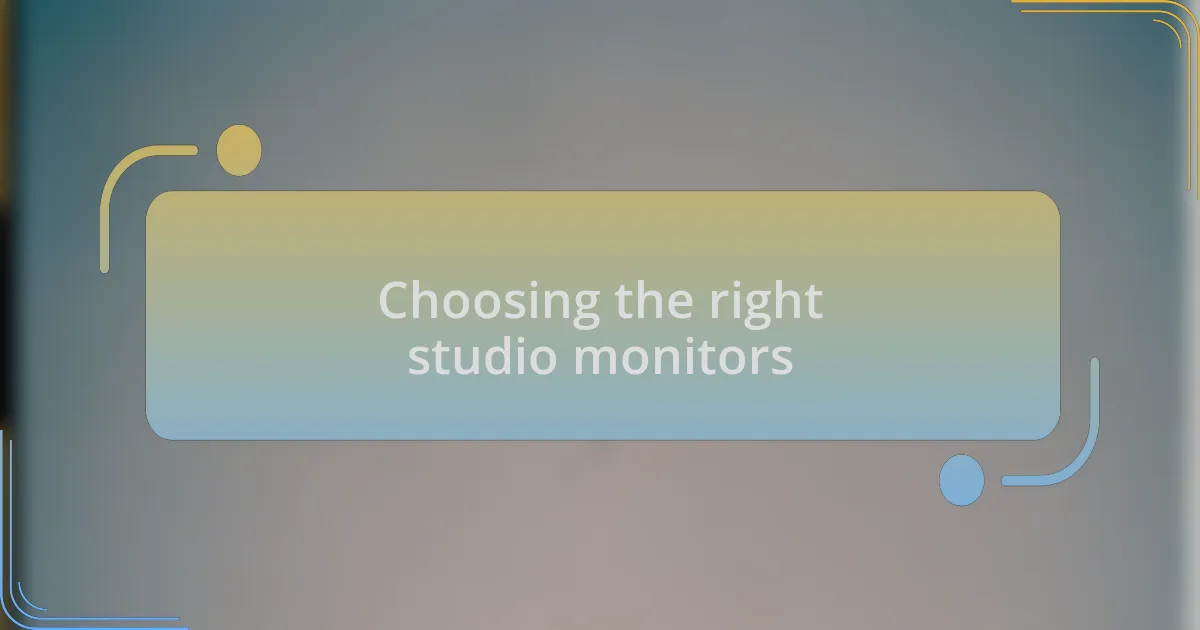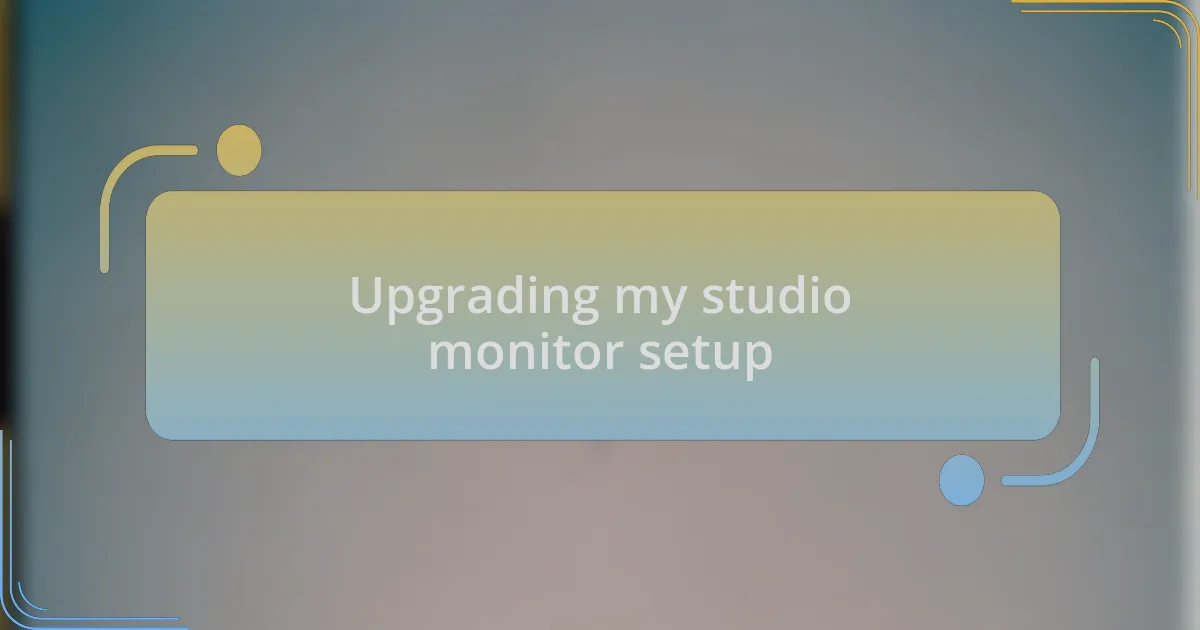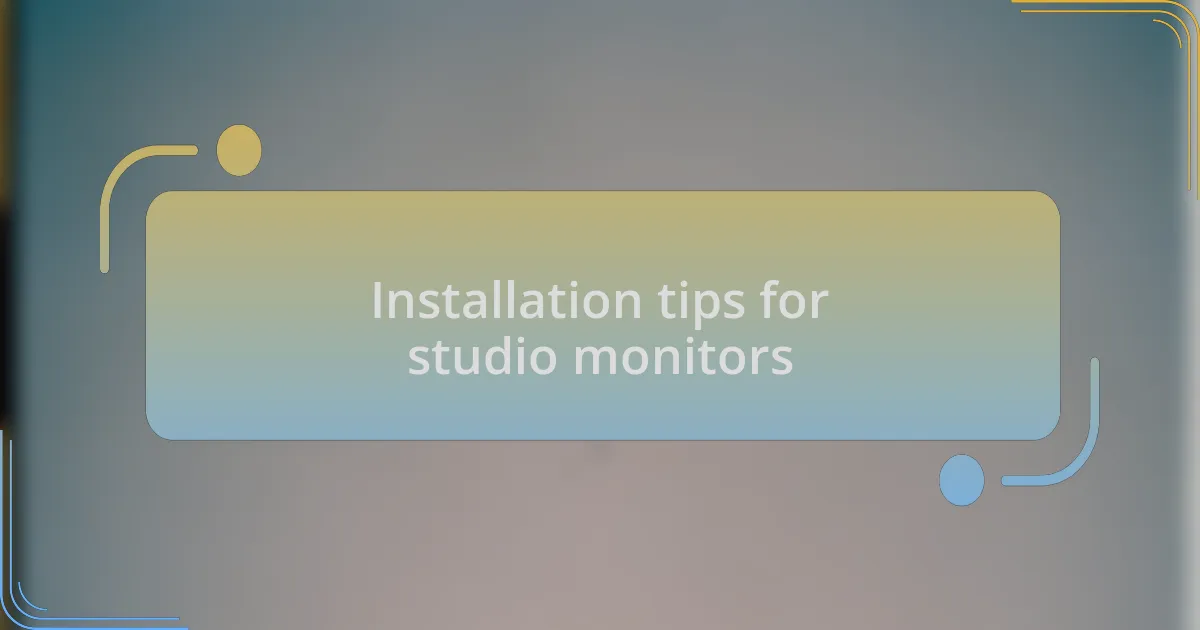Key takeaways:
- Studio monitors provide accurate sound reproduction, essential for making informed audio mixing decisions, unlike consumer speakers that enhance certain frequencies.
- The choice of studio monitors should align with your specific needs and acoustic environment, considering factors like speaker drivers and connectivity options.
- Upgrading monitors can significantly enhance sound clarity and depth, while proper placement and acoustic treatment further improve listening experiences.
- Installation tips include setting monitors at ear level and away from walls to reduce unwanted reflections, and using isolation pads to minimize vibrations.

Understanding studio monitors
When I first stepped into the world of film production, understanding studio monitors felt a bit like deciphering a complex language. Studio monitors are specially designed speakers that deliver accurate sound reproduction. They allow you to make informed decisions about your audio mixes, something I realized was crucial after a few disappointing screenings. Have you ever listened to a mix on regular speakers, only to find it sounded completely different in the theater?
The difference between studio monitors and consumer speakers is striking. While consumer speakers often enhance bass or treble to make music sound more appealing, studio monitors strive for neutrality. This means what you hear is as close to the original recording as possible. I remember the moment I first switched to a pair of professional-grade monitors. The clarity was astounding, and I could finally hear all the subtle nuances in my projects that I had previously missed.
It’s essential to consider the size and acoustic treatment of your studio space when choosing monitors. Bigger speakers can provide more powerful sound, but they can also overwhelm a small room. In my own experience, I’ve often found that the best sound comes from monitors that fit well within the acoustic environment I’m working in. Have you thought about how your space affects your audio choices?

Choosing the right studio monitors
Selecting the right studio monitors is more than just picking a brand; it’s about understanding your specific needs and environment. When I was on the hunt for monitors, I spent hours listening to different models in various settings. The experience taught me that what sounds great in one studio might not necessarily work in yours. Have you considered how your listening habits influence your monitor choice?
Another critical factor is the type of speaker drivers used. For instance, I found that monitors with a woofer and tweeter combination provided a well-rounded sound, which was vital for my film scores. I remember a key scene in my latest project where the low frequencies added depth and emotion; my old monitors simply couldn’t reproduce that essence. How do you plan to balance frequency ranges in your mixes?
Lastly, don’t underestimate the importance of connectivity options. Early on, I overlooked this aspect and ended up frustrated when my monitors didn’t integrate seamlessly with my setup. I learned that options like XLR and TRS connections can significantly simplify your workflow. Have you thought about how connectivity can streamline your creative process?

Upgrading my studio monitor setup
Upgrading my studio monitor setup changed the way I approached sound entirely. After months of grappling with inaccuracies in my mixes, I decided to invest in a pair of monitors that I had been eyeing, known for their clarity and depth. It was a bit of a leap for me, but the moment I set them up and played back some of my recent projects, I was blown away by the difference – it was like putting on a new pair of glasses.
I also learned that tweaking the placement of these monitors in my studio made a world of difference. When I initially positioned them, I noticed a significant imbalance in the sound, particularly in the mid-range frequencies where my dialogue often lived. After some trial and error, I found that angling them just right and ensuring they were at ear level transformed my listening experience. Have you thought about how monitor placement can affect your auditory perception in your space?
Lastly, integrating acoustic treatment into my setup proved invaluable. I vividly recall the first session after adding bass traps to my corners; it felt like unlocking a new layer of dynamics in my mixes. No longer was I battling with muddiness; the clarity was astonishing. If you’re considering an upgrade, have you explored the potential impact of your room’s acoustics on your monitors?

Installation tips for studio monitors
When it comes to installing studio monitors, I can’t stress enough the importance of finding the right height. Initially, I set mine on a desk that was a bit too low, and I quickly realized that I was straining my neck while trying to mix. After elevating them to ear level, the improvement in sound clarity and my overall comfort during long sessions were game-changers.
I’ve also learned that keeping monitors away from walls can drastically reduce unwanted reflections and resonance. In my own experience, I once placed my monitors too close to a corner, and the result was a booming bass that made it almost impossible to judge the low end accurately. Creating some space – I personally aim for at least a foot – not only cleared up the muddiness but also allowed my sounds to breathe properly.
Another tip is to experiment with isolation pads. I noticed that placing my monitors on these pads minimized vibrations transferring through my desk, which can really alter the sound. Have you felt the difference after tackling vibrations in your setup? If you haven’t tried it, I would highly recommend it; it could dramatically enhance the precision of your mixes.

Personal experiences with upgrades
It’s funny how one small change can lead to a significant improvement. I remember when I upgraded my studio monitors from entry-level models to more professional ones. The moment I turned them on, I could hear details in my mixes that I never knew existed. It was like someone had lifted a veil from my ears, and I felt a sense of empowerment, knowing I could trust my mixes much more.
In my experience, the process didn’t just stop at purchasing new monitors. I spent hours tweaking their placement and adjusting settings to fit my room’s unique acoustics. One particular afternoon, I discovered that slight adjustments in angle dramatically changed the stereo image. I was both frustrated and elated, often asking myself, “How did I not notice this before?” Those little moments turned the upgrade from a mere change in equipment to a whole new layer of creativity in my work.
I still vividly recall the first mix I did with my upgraded monitors. My heart raced as I pressed play, eager to hear the improvements. The low end was deeper, the highs were clearer, and everything just felt more cohesive. It was a revelation; I couldn’t help but smile, feeling like I had unlocked a new level in my production journey. Have you ever had a similar experience? It’s thrilling to think how the right gear can fundamentally alter the way we create.